#dccah
Video
The Pew Research Center confirms a trend nearly every US survey conducted over the last twenty-five years has shown: the remarkable decline in religiosity and deference to religious institutions and dogma within American society. Black Americans (despite a much slower decline) are no different.
I am an artist first. A singer-songwriter, musician, arranger and producer. But I am also a humanist; a critical thinker, self-identified with the tradition of revolutionary Black Freethinkers and powerhouses before me from Makandal to Frederick Douglass, Hubert Harrison, Lorraine Hansberry, James Baldwin, Sikivu Hutchinson and so many more.
I lend my voice to this cause blending artistry and activism. World history, US history and my personal history demands this. And while I have been called every name in the book by many of my fellow Black Americans, their misunderstandings, bigotry and ignorance cannot be my preoccupation. I speak with the same voice of resistance as the ancestors previously mentioned; the ancestors that helped bind the hands of the oppressor and gain liberation for ourselves and our families. I speak with a prophetic voice, not borne of superstition but of the realization of what current circumstances, trends and history predict vis-a-vis demonstrable facts and precedents. Black History is alive and well within me and I will always be proud of standing up for myself and the dignity of reason, autonomy and ethics. For these things, as well as my art, will be my legacy.
_____________________
-Rogiérs
🎵 www.FibbyMusic.net
Host, Where We’re Headed, Podcast wwh.podbean.com
Director, Black Nonbelievers of DC www.Facebook.com/BNofDC
#Freethought#Artivist#Black Secular#Sikivu Hutchinson#DCCAH#Black History Month#BLM#BNDC#American Humanist Association#Where We're Headed#Black Podcaster#Podcast#Black Music Month#Indie Artist#Fibby Music#Rogiérs Fibby#Black Nonbelievers#Pew Research Center#Religious Freedom#Dogma#Critical Thinking#Frederick Douglass#lorraine hansberry#James Baldwin#Makandal#Haitian Revolution#Documentary#Organized Religion#Evangelical#Deconstruction
0 notes
Photo
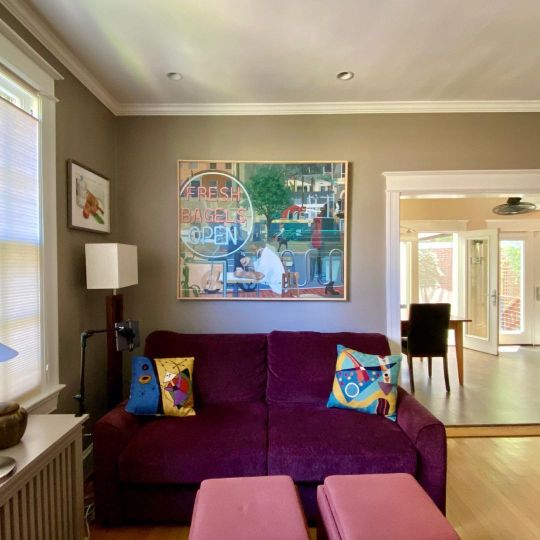
Bagels (oil on linen; 44x54”) now in collector’s beautiful home in Washington, DC. #dccah #alexandriaartscommission #torpedofactory #dcartist #corcoran_gw #theartleague #fineartconnoisseurmagazine #dc #cityscape #bagel #finearttoday #oiloncanvas #womenartists #oilpainting #contemporarypainting #realism #contemporaryartcollector #artcurator #principlegallery #zenithgallery (at Cleveland Park) https://www.instagram.com/p/CQfDkfphREj/?utm_medium=tumblr
#dccah#alexandriaartscommission#torpedofactory#dcartist#corcoran_gw#theartleague#fineartconnoisseurmagazine#dc#cityscape#bagel#finearttoday#oiloncanvas#womenartists#oilpainting#contemporarypainting#realism#contemporaryartcollector#artcurator#principlegallery#zenithgallery
0 notes
Photo

25% off all Head-Roc Fashion and Music from www.head-roc.com From this moment until the Federal Shutdown ENDS! Use code "BLACKROCKSTARSUPERHERO" to enjoy 25% off at Checkout from www.head-roc.com/estore Yes... 25% off TONS of Music to Download from Head-Roc's Soundcloud Page at No Cost! Music to get America through these Times! Head-Roc #blackrockstarsuperhero #chocolatecityrocks #fashion #dcartists #dcfashion #governmentshutdown #dccah #pgcounty #dcfashion #style #panafrican #tees #hoodies #bluecollar #feds #dcemployee https://www.instagram.com/p/BsVg5dmBWcK/?utm_source=ig_tumblr_share&igshid=u0hmnmf11onz
#blackrockstarsuperhero#chocolatecityrocks#fashion#dcartists#dcfashion#governmentshutdown#dccah#pgcounty#style#panafrican#tees#hoodies#bluecollar#feds#dcemployee
0 notes
Photo
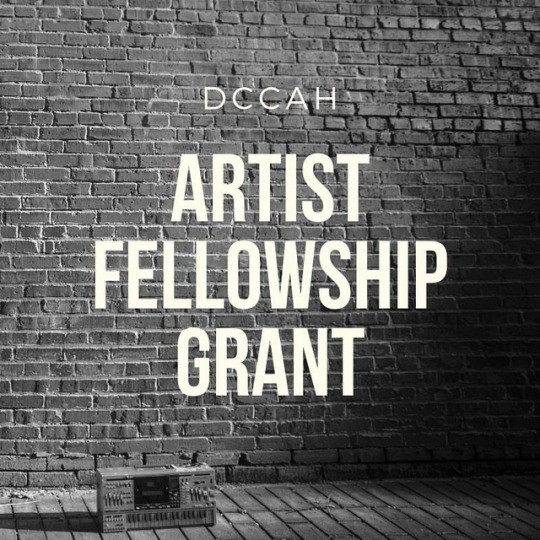
Shouts to @thedcarts received news that I was awarded an artist fellowhip and the sister cities grant to examine the intersection of creativity and coffee culture with @beatsnbeans in Addis. Prayers go up, hard work gets done, blessings come forth. God is good. Can’t wait to get this good art cracking. #202creates #beatsnbeans #dccah https://www.instagram.com/p/Bohg2ArAAwr/?utm_source=ig_tumblr_share&igshid=68xqf74kpadh
0 notes
Video
🌍 #MuralMonday // "100 years of Afro -American history" #NannieHelenBurroughs ✊🏽#NomadicInsight // #DCCAH 🎨
0 notes
Photo
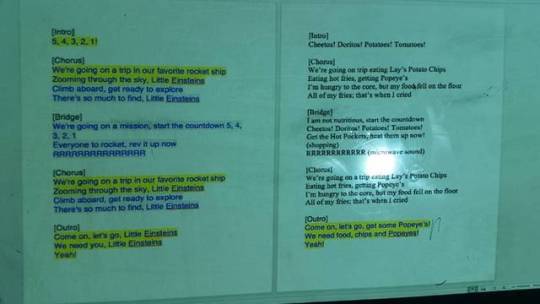
The silly spoof of the #LittleEinstein theme that we came up with in Mr. Brown's 7th grade music class at Cap City. #SpoofSchool is usually a 5 day residency, so I was impressed with what this class was able to pull off in 3 days with only 1 day of writing. Shout out to the DC Commission on the Arts and Humanities and the #CreativeSpark grant! #dccah @dccah (at Capital City Public Charter School)
0 notes
Text
ArtsAction DC Advocacy Day 2017
Submitted by: Eva Steinhardt, DC Collaborative Communications Intern
Wednesday, March 29, 2017
From The Hill to The Wilson Building
On March 22, the arts and humanities community of DC moved from The Hill, where they had been gathered for Americans for the Arts National Arts Advocacy Day, to the John A. Wilson Building for our local ArtsAction DC Arts Advocacy day!
The day started off with an advocacy training session led by DC Collaborative's Lissa Rosenthal-Yoffe and national advocacy briefing provided by Americans For the Arts. Throughout the day conversations and meetings were held between DC government officials, and the caretakers and advocates, of Washington’s arts and humanities spaces, programs, educators, artists and creatives.
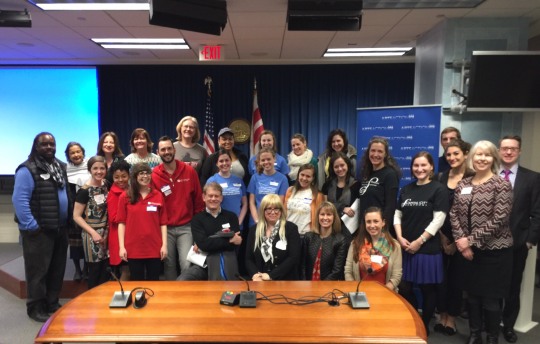
The message these advocates sought to share was a unified one. Three requests were made in every meeting - whether the meeting was held with a councilmember, a staff representative, or Mayor Bowser. These requests were:
Return Funding of DC Commission for the Arts and Humanities to at least $25 Million
Provide Financial Support to Implement the DC Cultural Plan (upon its completion in April)
Develop a new funding cohort for the Commercial Arts/Professional Services Sectors of the Creative Economy
Organized by ArtsAction DC, these three requests summarize the legislative priorities of our local arts and humanities community. Our cultural organizations, artists and educators are looking towards a future where The District both sustains and is sustained through an investment in arts and humanities. This hopeful tone was conveyed in yesterday’s meetings, as culture advocates shared their stories, and vision, with local representatives.

ArtsAction DC Members, including DC Collaborative’s Executive Director Lissa Rosenthal-Yoffe, meet with Mayor Muriel Bowser, Kay Kendall, Chair, DC Commission on the Arts and Humanities (DCCAH) and Arthur Espinosa, Jr., Executive Director, DCCAH.
Politics and Art: A Jam Session
However ArtsAction DC Arts Advocacy day wasn’t confined to the meetings that took place. Armed with the understanding that the cultural scene of DC needs to be experienced in order to be understood, and that arts and humanities speaks loudest for itself, ArtsAction DC brought arts and humanities popups from across DC into the Wilson building’s corridors. This effort was complimented by Politics and Art: A Jam Session - organized by DC Collaborative Member Washington Performing Arts - that took place in the Wilson Building lobby that evening.
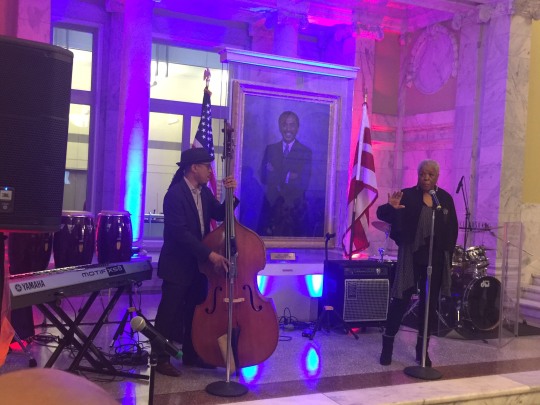
Politics and Art: A Jam Session, was an opportunity for the arts and humanities community of DC to come together in a creative, and meaningful, space. Rainbow drapes decorated the entrance hall pillars and the lobby became a stage where local musicians (including the Alice Deal School Jazz Band and other youth groups) were invited to preform. It was a rare opportunity to gather our arts and humanities community together to exchange ideas and visions for future collaboration.
The event did not go unnoticed by government officials in the building and many came to explore the scene - wandering the exhibition tables and learning about the many programs offered by a range of organizations. Some, such as Councilmember Grosso, Chair, Committee on Education and Councilmember Robert White, Jr. stepped up the stage and shared remarks on the value of the arts and humanities in the city. Thanks Councilmember Grosso for the DC Collaborative shoutout and for all you do to help ensure students have equitable access to the arts and humanities!
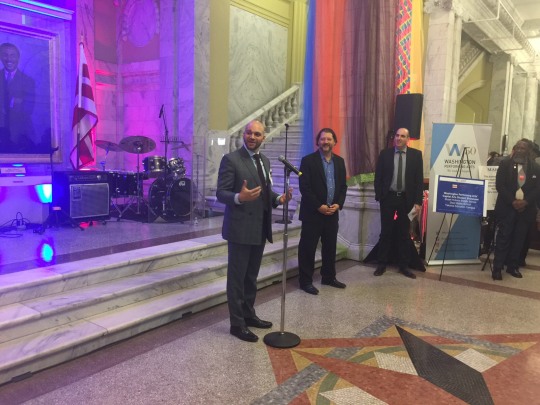
DC’s Arts Advocacy day capped off a week of national advocacy, by shifting the attention back to our local community, and bringing together a diverse range of arts and humanities stakeholders from across the city.
Quick Links
DC Collaborative Website
DC Collaborative Donation Page
Mayor Muriel Bowser
DC Commission on the Arts and Humanities
ArtsAction DC
Americans for the Arts National Arts Advocacy Day
ArtsAction DC Local Arts Advocacy day
Washington Performing Arts
Politics and Art: A Jam Session
Councilmember Grosso, Chair, Committee on Education
Councilmember White
#DCArts#202Creates#CollaborativeEffect#CollectiveImpact#News#StoryBank#BeTheVoice#AADC#ArtsEd#HumanitiesEd#ArtsAndHumanitiesForEveryStudent#DCCollaborative#DCCAH#ArtsActionDC#DC#Arts Advocacy#Humanities#Humanities Advocacy#general news
0 notes
Photo

This is such a random pic but it’s how my morning started meeting my mom for breakfast at the Parkway Deli & Restaurant, where we’ve both been going since I was in her belly. She told me a story today about the waitresses asking her if she stopped cooking cuz she showed up there almost everyday for breakfast and lunch while I was in utero. So apparently I have them to thank for my 9 mo. survival... I wanna close out the new year by showing appreciation for the end of 2017 as I am one of the artists to receive a DC Arts & Humanities Fellowship Grant. Thank you @thedcarts. 2018 is already lining up with 3 residencies, new exhibitions, traveling, fairs and most importantly, being given the time to develop new work, your generosity DCCAH will be put to good use. I also wanna give a shout out to my acupuncturist Jill whose helping me get over this cold and fatigue. As many have already shared, 2018 already feels great. Cheers to not feeling burnt out for an entire year. (at Parkway Deli & Restaurant)
1 note
·
View note
Video
vimeo
This is the DCCAH video for the Augmented Reality project "A/Re You There?" The work you see here is both intended to be a stand alone, viewable anywhere in the world by anyone with a smartphone and QR code and App (which is free) and also as a duet, performed live and as a hologram by Jason. Capture and processing by Tobias Chen and Volumetric Capture Systems. Funding by the DC Commission on the Arts and Humanities and the City of Sunderland, England. Partner: New World Designs, Sunderland.
0 notes
Photo
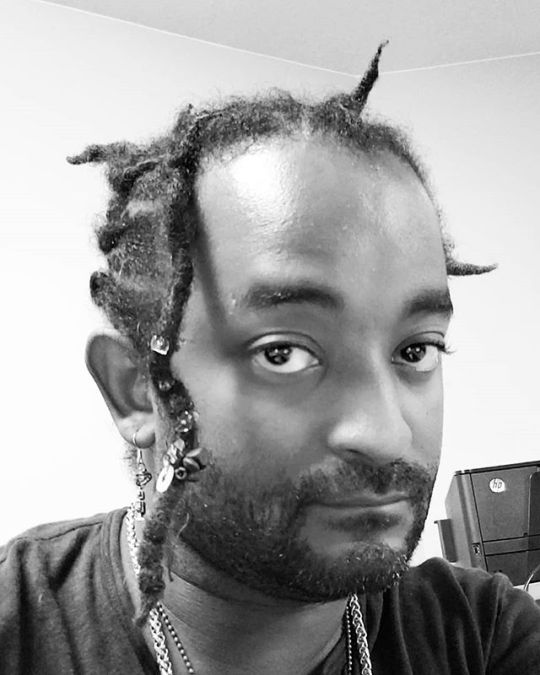
This is the face of a man who received 2 DCCAH grants. . *insert celebrations* . *returns to being broke* . #ThatPoetryHost — view on Instagram https://ift.tt/2nLBB7r
0 notes
Text
A Washington, D.C., cultural commission abandoned changes to its funding initiative amid allegations of censorship.
The D.C. Commission on the Arts and Humanities (DCCAH) recently added an amendment to its public funding initiative, alerting artists who had already signed contracts via email that it prohibits “lewd, lascivious, vulgar, overtly political, and/or excessively violent” works. After artists portested and the American Civil Liberties Union (ACLU) began investigating the possibility of filing a lawsuit against DCCAH on the grounds that the measure violated First Amendment rights, DCCAH repealed the controversial stipulation Thursday evening.
In a statement quoted by the Washington Post, the organization wrote:
The DC Commission on Arts and Humanities believes deeply in the right to freedom of expression and would never seek to violate that right by censoring the work of any grantee. Mayor [Muriel] Bowser’s steadfast commitment to our diverse and vibrant Arts and Humanities community will not waver. We look forward to a continued investment and collaboration with our District creative community.
As Hyperallergic points out, the swift action on repealing the amended contract happened in large part due to pressure put on DCCAH by D.C. groups such as the Washington Project of the Arts. International Arts & Artists brought the story to the media’s attention while online arts criticism platform DIRT spoke out about the censorship controversy on social media.
from Artsy News
0 notes
Photo

My 3 little ones sold to one of my favorite collectors! 1) I'm Into You (red Vespa), oil on panel, 14x11"; 2) U-Haul (blue scooter), oil on panel, 14x11"; 3) Struttin' (yellow Daytona), oil on panel, 16x20". Thank you Mel Odilao!!! #thedcarts #cityscapepainting #dccah #alexandriaartscommission #torpedofactory #corcoran_gw #theartleague #fineartconnoisseurmagazine #finearttoday #oiloncanvas #womenartists #oilpainting #contemporarypainting #realism #contemporaryartcollector #artcurator #principlegallery #zenithgallery #mdfederationofart #vespa #daytonabikeweek2021 #scooter #uhaul (at Washington D.C.) https://www.instagram.com/p/CNcnZPBhn-Y/?igshid=1iz5kimmpprs8
#thedcarts#cityscapepainting#dccah#alexandriaartscommission#torpedofactory#corcoran_gw#theartleague#fineartconnoisseurmagazine#finearttoday#oiloncanvas#womenartists#oilpainting#contemporarypainting#realism#contemporaryartcollector#artcurator#principlegallery#zenithgallery#mdfederationofart#vespa#daytonabikeweek2021#scooter#uhaul
0 notes
Photo

Chocolate City Rocks Presents a Black Rock Star Super Hero Night concert event spotlighting Watusi w/ Tribe of Asaru Date: Sunday, September 30,2018 Time: 7p-11p Location: Velvet Lounge, 915 U Street NW DC Door Cost: $15 ($5 & $10 online purchase options) performing live: 8pm Producer Showcase w/ Deo 8:30pm Head-Roc War Machine 9:10pm R.Y.E Bred Project intermission w/ KXNG R.G. 9:30pm Watusi w/Tribe of Asaru 10:15pm Conclusion/Cypher 11pm Go Home Web links: Watusi w Tribe of Asaru Head-Roc DJ Dub Deo #blackrockstarsuperhero #ChocolateCityRocks #washingtondc #dmvmusicians #dchiphop #dmvhiphop #newmusic #hiphophead #blackbroadway #ustreetdc #velvetlounge #washingtoninformer #202Creates #dccah #kennedycenter #ryebread #kxngofthedistrict https://www.instagram.com/p/BnRCifxgH3d/?utm_source=ig_tumblr_share&igshid=1o44oj59jw2dz
#blackrockstarsuperhero#chocolatecityrocks#washingtondc#dmvmusicians#dchiphop#dmvhiphop#newmusic#hiphophead#blackbroadway#ustreetdc#velvetlounge#washingtoninformer#202creates#dccah#kennedycenter#ryebread#kxngofthedistrict
0 notes
Photo
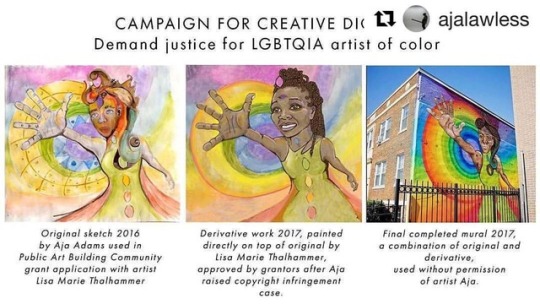
Because Artistic Integrity Matters. Black thoughts shouldn't be painted over and discarded to "become" someone else's. Go to @ajalawless and sign the petition if black art and black thoughts matter to you! • #Repost @ajalawless ・・・ Yall, this morning was a blow. I've been outside the states for almost a year and fighting with the @thedcarts and @lisamariestudios over copyright infringement of a mural that was just painted in Washington, DC. Lisa Marie blocked me from every channel of communication, but a friend sent me a picture like, "Hey, your in DC, isn't this yours?" I find it unjustifiable to not give credit to an artist of color to paint a person of color for a community of color. I wonder why we praise these white artists who falsely hide under the guise of white feminism, equality, and love—just for a paycheck. This artist won $50,000 off an idea and design that wouldn't exist without me, or the person of color who started the art program at Open Arms, the shelter for women of color where the mural is now painted. I have yet to receive a check, or let alone credit for the piece. The DCCAH allowed this woman to get away with copyright infringment and using funds for her own personal gain. And of all people, she hired another white woman, Anna Sutton, to help paint the mural. I know, surprising right! Who does an artist like me hold accountable? I'm at a loss, since the government has been conspiring with artists like Lisa Marie Thalhammer for decades now, despite my persistent involvement and demands for justice. Please, I ask you to contact Lisa Marie and the DC Commission on the Arts and Humanities to hold a conversation with them about why they believe its okay to not pay the artist and give credit or demand to have the work taken down. I welcome all discussion as I continue forward in this fight. Stay tuned for more details and articles we'll be sharing this week. Please share and demand #dignity you can check my bio to sign the petition and hold the Dccah and @lisamariestudios accountable peace and abundance
0 notes
Text
Hyperallergic: Why Eliminating the National Endowment for the Arts Would Hurt Rural Americans the Most
Inaugural Riverfest artist-in-residence Wayne White shows off large-scale puppets in Wichita made in collaboration with local artists at the festival’s Sundown parade (photo courtesy of Wichita Festivals, Inc., Wichita, KS)
President Trump’s proposed federal budget for 2018, released last week, made official what arts advocates had long feared: he is calling for the elimination of the National Endowment for the Arts (NEA), the National Endowment for the Humanities (NEH), and the Institute of Museum and Library Services (IMLS). The implementation of these cuts is by no means guaranteed — the budget’s unprecedented slashing of the social safety net and drastic cuts to major agencies will encounter resistance from Democrats and, in some cases, even from moderate Republicans. But with the Republicans controlling Congress, it is likely that some of Trump’s budget proposals will eventually be implemented. Moreover, the budget stands as a statement of the President’s priorities, a message to the country about what this administration cares about — and what it doesn’t.
The NEA has long been a target for the right and, specifically, for the Heritage Foundation, a conservative DC think tank whose budget blueprint provided the basic framework for Trump’s plan. Heritage has long argued that NEA spending is wasteful, little more than welfare for rich coastal elites. Evidence proves otherwise. In reality, the NEA has an outsized impact in rural communities and less densely populated states, where funding from private foundations and wealthy philanthropists is harder to obtain. With a budget of only $149.8 million (that’s roughly .003 % of annual federal spending), the NEA’s resources are extremely limited. The agency partly focuses on using the funding it can provide to help its grantees — especially smaller and less well known organizations — attract additional funding from other private and public sources.
The NEA’s outsized impact on rural areas and less densely populated regions is reinforced by the way it distributes the funding it provides directly to states. Since 1998, a full 40% of the NEA’s grant-making budget has been paid out to state arts agencies and regional arts organizations as block grants through partnership agreements. In order to qualify for the partnership agreement block grants, states must develop a state arts plan, have a state arts agency that will manage the funds, and match the NEA funds dollar for dollar with state appropriations.
Matt Dehaemers and Mark Cowardin lead a demonstration with the M’Assim Tovim youth group during a repurposed wood and brush art-making workshop. (image Courtesy of the Epsten Gallery, Overland Park, KS)
The matching fund requirement creates a web of interconnections in the US cultural funding ecosystem that includes 56 state arts agencies (for 50 states, five territories, and the District of Columbia) and six Regional Arts Organizations. The states receive NEA funding, but only if they meet the NEA’s partnership agreement requirements. The Regional Arts Organizations, private non-profit organizations that also receive a portion of their funding from the NEA, distribute additional funds to artists and arts organizations in their member states, especially for projects with a regional impact. The Regional Arts Organizations all have their own membership agreements, but they often require that their members maintain a qualified partnership agreement with the NEA, further incentivizing states to remain in good standing with the Endowment. (Full disclosure: the author is employed by an organization that receives funding from the DC Commission on the Arts and Humanities, the state art agency for the District of Columbia. DCCAH received 3.2% of its fiscal year 2017 funding from the NEA.)
The elimination of the NEA would destroy the foundation of the country’s funding network, leaving arts organizations across the US more isolated and with fewer resources for cultivating additional private and public funding. Due to inequities in state funding, certain states would feel the impact more deeply than others. In fiscal year 2017, the revenue of the New York State Council on the Arts was over $46 million dollars — by far the largest of any state arts agency. Only $866,000 of that — or 1.9% — came from the NEA. Wyoming, with an annual state arts budget of just under $1.8 million dollars, received $700,000 — or almost 40% — of its FY2017 arts funding from the NEA. According to the National Association of State Arts Agencies’ Fiscal Year 2017 Revenue Report (the source of many of the funding statistics included here), American Samoa, Georgia, Idaho, Kansas, Maine, Montana, New Hampshire, North Dakota, South Dakota, Vermont, the US Virgin Islands, and Wisconsin all received 40% or more of their 2017 state arts agency funding from the NEA.
The state and regional funding networks have been challenged in recent years by cuts to state government funding for the arts. Earlier this year, the Mississippi Arts Commission (MAC) survived a Republican-led attempt to dissolve the agency and hand its duties over to the Mississippi Development Authority. Those efforts came on the heels of a budget reduction for MAC, which experienced an 11% cut in its state appropriation from 2016 to 2017. Oklahoma and New Mexico, two other states that are in the midst of budget crises, also experienced major cuts to their state arts funding from 2016 to 2017, with a 16% cut in Oklahoma and an 18% drop in New Mexico. Recent struggles faced by arts organizations in Kansas and Iowa demonstrate just how vital public culture funding is in those states, and how devastating the elimination of the NEA could be for artists and arts workers in similar funding ecosystems.
Raiding the Culture Coffers in Iowa
In Iowa, the state’s $6 million Cultural Trust was gutted by the Governor and State Legislature in January and the state appropriation to the Iowa Department of Cultural affairs was reduced by $210,958 for the remainder of 2017, both as part of an effort to close the state’s 2017 budget shortfall. On the final day of the legislative session, a provision was added to the final spending bill that eliminated Iowa’s Art in State Buildings program, which required that .5% of spending on state government buildings be set aside for public art. The program, which was started in 1979, had been especially significant for the state’s public universities, resulting in significant collections of public art on the campuses of the University of Iowa and Iowa State University.
The Des Moines Art Center (photo by Des Moines Guy, via Wikimedia Commons)
Reached by phone, Jeff Fleming, Director of the Des Moines Art Center, expressed fears that the state cuts, as well as any potential cuts to the NEA, would fall hardest on rural Iowans. In Des Moines, Fleming explained, there are other options for funding, including Bravo Greater Des Moines, which is funded in part by hotel-motel tax revenue from Des Moines and surrounding communities. The state’s Department of Cultural Affairs, which makes an effort to fund projects in all 99 of Iowa’s counties, is the only major funder in many rural areas. But even for organizations that might have other options, Fleming explained, the loss of public funding is about more than the monetary value it provides. Public funding from the NEA and the state and regional funding networks brings with it a sense of validation and a feeling that artists and arts organizations in Iowa are part of a broader system of support. That connection can’t be replicated by funding from private sources. Furthermore, Fleming fears that the recent cuts in Iowa represent something more than belt-tightening, what he termed “a devaluation of culture, of critical thinking, of creative enterprises, of intellectual thought, and scientific inquiry.”
Kansas Struggles to Rebuild Its Arts Funding
Since 2011, artists and arts organizations in Kansas have experienced firsthand the damage that can come from losing access to the network of public funding for the arts. As part of his conservative overhaul of the state budget, Governor Sam Brownback used the line-item veto to completely defund the Kansas Arts Commission in 2011, making Kansas the only state in the country without a functioning state arts agency. Although state arts funding was restored in 2012, with the establishment of the Kansas Creative Arts Industries Commission (CAIC), Kansas went without NEA matching funds for two years, losing its membership status in the Mid-America Arts Alliance during the same period. For 2017, Kansas again struggled to reach the matching funds requirement. For this fiscal year, CAIC received $225,604 in direct funding from the state of Kansas. That allocation, along with state funding of arts-related initiatives in the Department of Commerce, met the minimum requirements of Kansas’s partner agreement, allowing it to receive $637,600 from the NEA for 2017.
State cuts and inconsistent availability of federal and regional funds have left Kansas’s arts organizations struggling to close funding gaps. In March, a New York Times article quoted Brenda Meder, whose organization, the Hays Arts Council, has struggled to survive without state or federal funding. The organization has had to cut expenditures to survive, slashing its administrative costs, reducing artists’ pay, and asking schools to chip in money for performances that it previously provided at no cost. Cuts to funding have also meant weakened networks for artists and arts organizations, according to Meder, who told the Times that artists in the state have become more “siloed” and “less engaged” since public funding has become scarce.
Art Instillation “CLOUD” by artists Wayne Garrett and Caitlin r.c. Brown during the Free State Festival in Lawrence, Kansas (photo by Ann Dean, courtesy of the Lawrence Arts Center Lawrence, KS)
Despite acknowledging these challenges, the article — titled “Can the Arts Thrive Without Washington? A Kansas Town Says Yes” — took an optimistic tone, painting a picture of gritty and determined artists and arts lovers dedicated to supporting culture in their communities no matter what. In a letter to the editor, 19 directors of arts groups in Kansas took issue with the article’s rosy outlook, pointing to the $3.3 million in funding that flows to Kansas every year from the NEA, the NEH, and the IMLS, stating: “The arts can and will persevere, but cannot thrive without federal support.”
Hyperallergic spoke by phone to Saralyn Reece Hardy, the Director of the Spencer Museum of Art at the University of Kansas and one of the 19 signatories of the letter. “It’s not even a question of ‘are the arts important’ — of course they are,” she said. “But when discussing federal funding, it has to do with all citizens having access, so we can build the diversity of our offerings, as well as our audiences.” Hardy stated that the elimination of the NEA would be felt across the state: “Kansas is a very grassroots state. It has urban centers and it also has many rural arts organizations — all benefit from a federal presence and federal support.”
Reached by phone, Peter Jasso, the director of CAIC, acknowledged that the loss of NEA funds would have a significant impact on his agency’s capabilities and force him to re-examine its spending priorities (this year, the NEA provided a full 73.9% of the CAIC’s funding). As the sole full-time employee of the CAIC, Jasso sympathized with the determined optimism reflected in the New York Times article. “You’re used to spinning straw into gold, in many ways,” he said. “That’s the mindset that many government employees have and many arts organizations have. You’re going to keep going as long as you can and try to do the best job you can.”
Collector Hal Wert talk with visitors about the exhibition Work, Fight, Give: American Relief Posters of WWII in February 2017 at Mid-America Arts Alliance. (photo courtesy Mid-America Arts Alliance)
Todd Stein, the interim CEO of the Mid-America Arts Alliance (the Regional Arts Organization that includes Arkansas, Kansas, Missouri, Nebraska, Oklahoma, and Texas), pointed to the recent congressional budget reauthorization — which included an increase in funding for the NEA for the second half of fiscal year 2017 — as a good sign. “Not only was the budget for federal cultural organizations not eliminated, it was increased and with strong bipartisan support,” he said. Still, his organization is committed to fighting for the NEA’s survival: “Our focus will be on advocacy from now until the budget is finalized.”
For her part, Hardy emphasized the importance of the connections that the elimination of the NEA could destroy. Public support, to Hardy, is about more than the money itself, but also about creating connections between artists, arts organizations, and audiences in Kansas and beyond. “It’s a network with high democratic ideals about what art should be and who it is for,” she said. “Because in America, it should be for all — and that is the mandate of federal funding. It is not for the few, it is for the many.”
The post Why Eliminating the National Endowment for the Arts Would Hurt Rural Americans the Most appeared first on Hyperallergic.
from Hyperallergic http://ift.tt/2somXQc
via IFTTT
0 notes
Text
Arts and Humanities for EVERY Student Blog Series
Collective Impact
Submitted by: Maya Simkin, DC Collaborative Programs and Communications Intern
Video by: Stone Soup Films
Friday, March 17, 2017
Arts and Humanities Education Advocacy
We are excited to present the third video in the short documentary series made by Stone Soup Films on our programs on our Collective Impact! These videos are part of this month’s arts and humanities advocacy initiatives, where we will be showing off our work and our members who are critical to cultural programming for student in DC. This video features Arthur Espinosa, Jr. of the DC Commission on the Arts and Humanities and several of our organized arts and humanities field trips to places like The Phillips Collection and Washington Bach Consort and Howard University Middle School for Math and Science. Thank you to to Stone Soup Films for helping us show off the highlights of our work! Next week we will be unveiling a mini-documentary for the end of the month!
Collective Impact Video Blog!
Third blog in the #ArtsAndHuamnitiesForEveryStudent series
vimeo
Arthur Espinosa describes watching the students light up in a way he never thought possible when they were taken backstage after a concert to meet the performers and ask questions. The interaction taking place on the actual set is unique in that it opens the curtains on how the arts get produced and pushes down the barrier between professional performers and the students.
He stresses the importance of making arts and humanities part of everyone’s daily experiences and of working with the community to impact the education of DC students. DC is host to some of the world’s best arts institutions, it’s important that students get to take advantage of it.

Thank you to to Stone Soup Films for helping us show off highlights of our work!
DC Collaborative helps upwards of 30,000 DC Public and Public Charter School students attend field trips throughout the school year. We are dedicated to providing access for all students to high quality arts and humanities education experiences like the ones in this video. Teachers can contact [email protected] for more information to sign up for these opportunities.
You can donate here to help us reach more students!
Thanks to Stone Soup Films for the video!
Quick Links:
DC Collaborative Website
Stone Soup
DC Collaborative Donation Page
#artseducation#artsed#collectiveimpact#collaborativeeffect#dcarts#phillipscollection#stonesoupfilm#dcps#artsandhumanities#Humanities#Humanities Ed#StoryBank#202Creates#DCCAH#news#AHFES news
0 notes